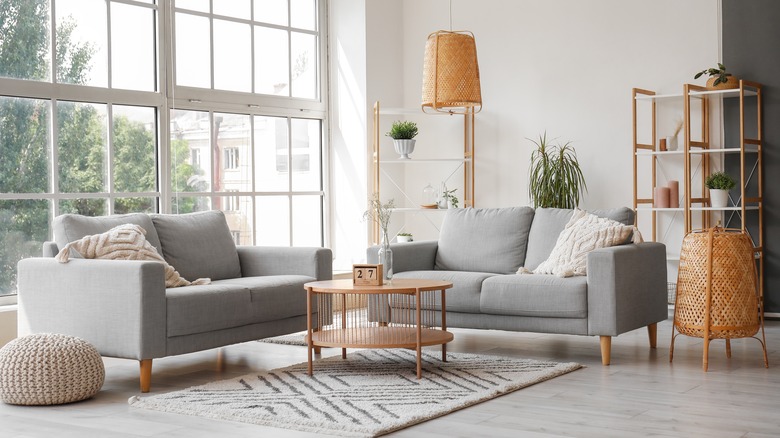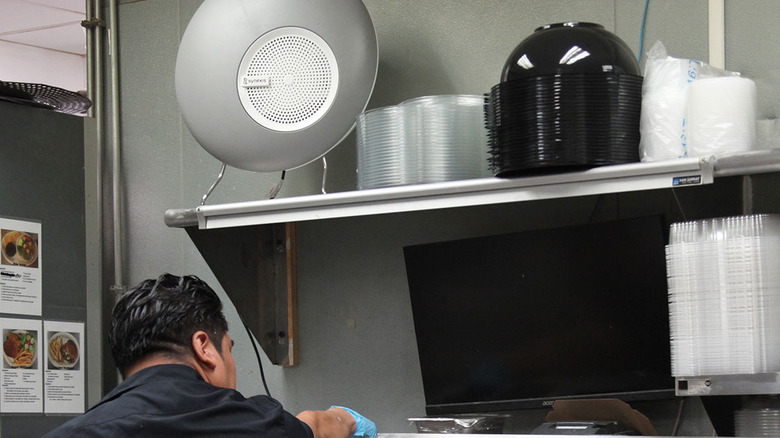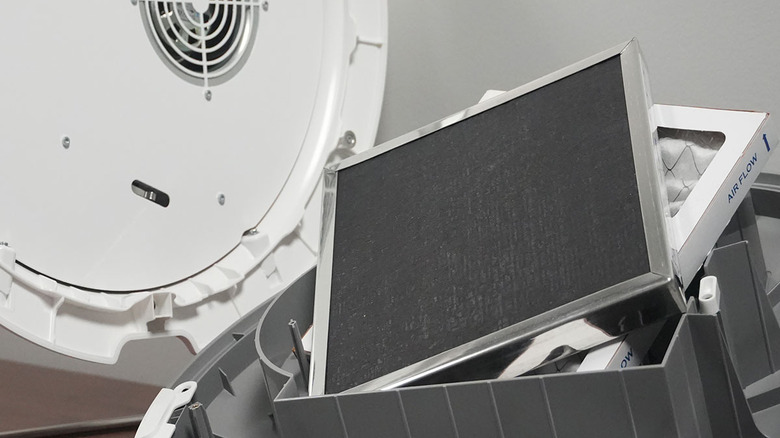The Air Purification Gadget That Will Be Popping Up In Homes (And Does It Really Work)
A promising antimicrobial technology has been used in hospitals, restaurants, and hotels for a decade could soon be finding its way into our homes. The first time you hear about it, you might be puzzled by its name: dry hydrogen peroxide (DHP). But this isn't the stuff you buy in the pharmacy aisle and, in fact, it's not something you buy at all. Pricey little machines manufacture DHP as a true gas (that is, not a vapor like aerosolized hydrogen peroxide) and, by most accounts, it circulates in the air nearby, destroying the bacteria, viruses, and mold spores it encounters along the way. We all knew hydrogen peroxide is one of the best substitute cleaners to use in a pinch, but who knew it could take a lead role like this?
These machines... there are currently three on the market, all offered by a company called Synexis... use a photocatalytic reaction to produce DHP from oxygen and moisture already in the air. It's meant to supplement manual disinfection, and has demonstrated some effectiveness at inactivating airborne bacteria, including drug-resistant ones. DHP is produced in miniscule amounts. A DHP-generating machine would have to run 2 ½ years to produce the same amount of H2O2 that's in a single droplet of the pharmacy stuff.
The advantages of DHP
Unlike mechanisms that vaporize standard hydrogen peroxide, DHP can be used in occupied spaces, and at far lower concentrations. DHP also has many advantages over other solutions like disinfectants, UV light, and vaporized agents, including hydrogen peroxide. Other solutions are ineffective in hard-to-reach areas and often involve using solvents and other chemicals. DHP was originally used for surface decontamination, and it is effective over a much larger area than other options. All of these other solutions tend to be more labor-intensive than DHP, with the exception of using antimicrobial materials for surfaces. But, unlike antimicrobial surfaces, DHP works against airborne microbes, and its wide area of effect isn't limited to particular surfaces. Note, though, that the Synexis Sphere includes DHP in addition to a UV disinfecting light and both carbon and MERC-11 particle filters, with the last two being reasonably effective on their own at getting rid of dust in the air.
DHP machines like Synexis's Sphere don't require maintenance beyond the semi-annual replacement of carbon, MERV-11, and photocatalytic filters (called "sails" by the company), as well as the replacement of a UV bulb every two years. The filter kit costs $450 from Synexis for the year, though Trane appears to sell the filters individually for $539.42 for one year's worth of replacements. Trane also sells replacement UV bulbs for other Synexis products, but we couldn't find the Sphere UV bulb for sale online. The Sphere itself currently costs $2,250, a bit less than you'd expect to pay to install a HEPA air purifier in your HVAC System.
Potential downsides of DHP
Critics of DHP technology sometimes focus on dated research of DHP's capabilities and efficacy. Competitor Halosil says DHP technology manages a 1-log reduction in microbes (90% effectiveness) versus HaloMist's 6-log (99.9999% kill rate. But research shows DHP is effective against SARS-CoV-2 virus, including 99.99% effectiveness against the Delta variant, which is consistent with the 4-log claim in Synexis's FDA filing. Other critiques include the claim that DHP isn't effective against airborne microbes, but recent research suggests that it is. Halosil also points out that DHP systems are not registered with the EPA or evaluated by the EPA or FDA. But the FDA has determined that the Sphere is exempt from premarket approval from the agency because it is substantially equivalent to other long-available UV air purification products. For its part, the EPA doesn't certify or register residential air-cleaning products. Synexis does produce them in an EPA-registered facility.
The biggest downside for homeowners, of course, is that there isn't yet a residential model on the market. The Sphere is the closest to a turnkey product homeowners might consider. It was designed for use in medical facilities, but in many ways is serviceable for homeowners. It covers 1,000 square feet, and plugs into a standard 110v receptacle (and works with 220v outside of the U.S.).


